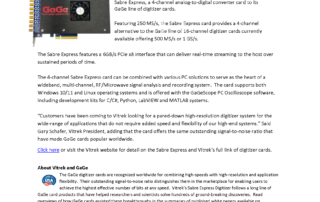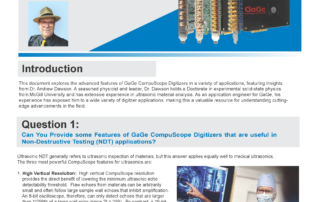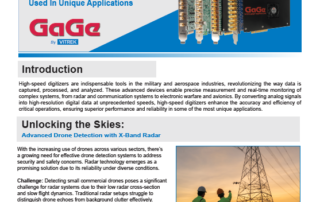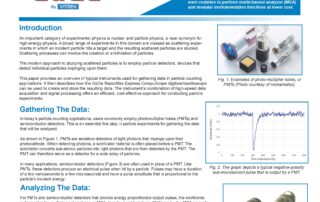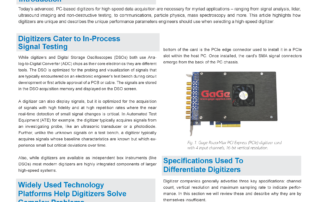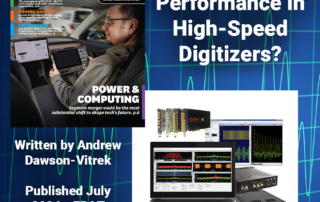Blogs
Digital Signal Processing
Digital Signal Processing Digital signal processing routines can be conducted on raw signal data acquired by GaGe high-speed digitizers either directly on the onboard FPGA of the digitizer card via our eXpert FPGA firmware features or can be optionally conducted on GPU cards receiving real-time streaming of raw signal data acquired by GaGe high-speed digitizers via the PCIe interface. eXpert FPGA DSP Optional firmware features that allow for signal processing analysis or other specific functionality to be performed on the digitizer hardware itself within its onboard Field Programmable Gate Array (FPGA). Features include [...]
Press Release: Vitrek Adds New 16-Bit Resolution, 4 Channel A/D Card To GaGe Product Line
Vitrek, LLC Expands Industry-Leading MTI PBS line to include the PBS eXpress™, a Portable Engine Balancing System for Business and Regional Jets Lightweight, portable system utilizes proven PBS technology for fast, highly accurate rebalancing of small-frame turbofan and turboprop engines
Portable Systems
Portable Systems The Signatec portable systems feature a built-in display, fold down keyboard with mouse touchpad, and solid state drive based storage array. With the provided digitizer cards and application software, they make a complete small package analog signal recording system.
FPGA DSP
GaGe provides several eXpert FPGA processing firmware options for use with CompuScope Digitizers. All standard default CompuScope Digitizer model configurations can store raw acquired waveform data to onboard sample memory and then transfer them quickly to the user for analysis, display and/or storage. The addition of optional eXpert FPGA processing firmware features allow for some signal processing analysis, or other specific functionality, to be performed on the digitizer hardware itself within its onboard Field Programmable Gate Array (FPGA). There are three primary advantages to the processing of waveform data using an eXpert firmware option. Data can be processed at [...]
The Answer Vault: GaGe CompuScope Digitizers — Q & A with Dr. Andrew Dawson
Introduction This document explores the advanced features of GaGe CompuScope Digitizers in a variety of applications, featuring insights from Dr. Andrew Dawson. A seasoned physicist and leader, Dr. Dawson holds a Doctorate in experimental solid-state physics from McGill University and has extensive experience in ultrasonic material analysis. As an application engineer for GaGe, his experience has exposed him to a wide variety of digitizer applications, making this a valuable resource for understanding cutting edge advancements in the field. Question 1: Can You Provide some Features of GaGe CompuScope Digitizers that are useful in Non-Destructive Testing (NDT) applications? [...]
Did You Know? GaGe Digitizers in Military & Aerospace Applications
Introduction High-speed digitizers are indispensable tools in the military and aerospace industries, revolutionizing the way data is captured, processed, and analyzed. These advanced devices enable precise measurement and real-time monitoring of complex systems, from radar and communication systems to electronic warfare and avionics. By converting analog signals into high-resolution digital data at unprecedented speeds, high-speed digitizers enhance the accuracy and efficiency of critical operations, ensuring superior performance and reliability in some of the most unique applications. Unlocking the Skies: Advanced Drone Detection with X-Band Radar With the increasing use of drones across various sectors, there’s a growing [...]
Did You Know? GaGe RazorMax Express Digitizer/Oscilloscope: An Efficient & Cost-Effective Tool for High-Energy Physics Particle Counting Applications
Introduction Figure 1. Examples of photo-mulitiplier tubes, or PMTs (Photo courtesy of Hamamatsu). An important category of experimental physics is nuclear and particle physics, a near synonym for high-energy physics. A broad range of experiments in this domain are classed as scattering experiments in which an incident particle hits a target and the resulting scattered particles are studied. Scattering processes can involve the creation or annihilation of particles. The modern approach to studying scattered particles is to employ particle detectors, devices that detect individual particles impinging upon them. This paper provides an overview of typical instruments [...]
Whitepaper: What Defines Performance in High-Speed Digitizers
Introduction Today’s advanced, PC-based digitizers for high-speed data acquisition are necessary for myriad applications – ranging from signal analysis, lidar, ultrasound imaging and non-destructive testing, to communications, particle physics, mass spectroscopy and more. This article highlights how digitizers are unique and describes the unique performance parameters engineers should use when selecting a high-speed digitizer. Digitizers Cater to In-Process Signal Testing While digitizers and Digital Storage Oscilloscopes (DSOs) both use Analog-to-Digital Converter (ADC) chips as their core electronics they are different tools. The DSO is optimized for the probing and visualization of signals that are typically encountered on [...]
What Defines Performance in High-Speed Digitizers? Published in Electronic Products & Technology July 2024
Download a PDF of this article
Unlock RF Spectrum Secrets with the GaGe CSE1622 Digitizer
Summary: High-speed spectrum sensing is essential in many radar applications and can be achieved by modern digitizers paired with radios. The GaGe CSE1622, a gallium-germanium 16-bit, 200-MS/s PCIe digitizer, is utilized for this purpose. It rapidly captures 40-MHz-wide snapshots of the spectrum, which are filtered and down-converted by the SI-8614 Nanoceptor receiver. The data is then processed using LabVIEW virtual instruments (VIs), optimized for near-continuous capture rates and efficient real-time monitoring. For optimal performance, a LabVIEW producer-consumer loop is employed. The producer loop quickly queues data captured from the digitizer; however, the consumer loop processes it slower using [...]

